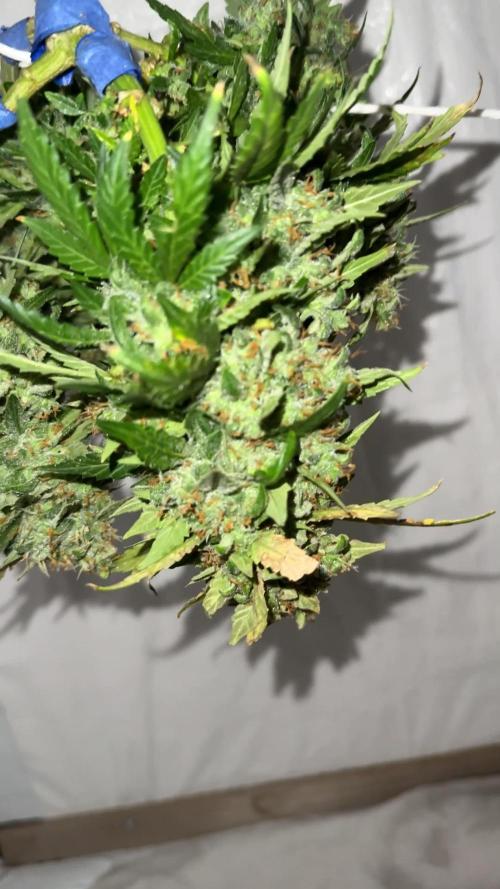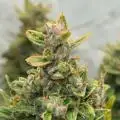The Grow Awards 2026 🏆 

































Likes
Comments
Share


@Marsledgrower
Follow
At least one plant or more is needing water daily as they are drinking so much.. still trying to pull the humidity down as it's in the high 60s. Other then that..the girls are looking phenomenal.. Hope to see you guys till the end..It's Going to be an Amazing Harvest
Processing
Likes
2
Share


@DIRTYKEG
Follow
Wow I love it so crazy and fun at this stage the defoliation was allot more work then I thought jeez..... but there looking beautiful but hope you like now I got to go defoliat the last 2...
Likes
Comments
Share


@Algar
Follow
Wanted to keep her growing until the end of the month but, mother nature had other plans. Woke up this morning and the buds where almost touching the ground. Still have 1/2 the plant left, will cut fown later today if more rain. Don’t have room to cure all at one time. Normally I cure outside, for now they’re in my bathroom and dressing room.😬Don’t know the wet weight for now since only cut 1/2 of the plant, but probably a good 4 or more kilos!😳
Finally, the sun has returned. Not hot though, but nice and sunny. Moved curing to outside for now. Last night we stayed high just from the aroma in the house. More to come when she dries.😍 Last plant totalled 2,005grams. 3 plant total 3,340 grams 😎
Likes
170
Share


@Tropicannibis_Todd
Follow
👉Alrighty Then👈
It's been a great week all plants are killing it ......... 👉it's Flipping Time 👈
👉So I topped all but Babba Kush and Slurricane they didn't require it ...
I've now started there nutrients program ,for the flip so we are set to go ......
Persian Pie from Greenhouseseeds
Full Gas from Greenhouseseeds
Babba Kush from Greenhouseseeds
Rainbow Melon from Fastbuds
Papaya Sherbet from Fastbuds
Weddingcheesecake FF From Fastbuds
Purple Oreoz F1 From Seedsman
Slurricane From Premium Cultivars
Soil by Promix
Nutrients by Cronks
Well this should be fun 🙃
Thanks to all my growmies out there for stopping by its much appreciated 👈
👉Happy Growing👈
Likes
39
Share


@AestheticGenetics
Follow
4/15/25 Things are progressing nicely. Some plants dont seem to be doing too much but 3 of them or so that are really standing out.
Im curious if some of these are going to be longer flowering time than anticipated with the very obvious sativa dominant plants.
Likes
19
Share


@Ieiogrow94
Follow
È stato un piacere coltivare questa genetica fantastica peccato per aver perso strain 2 causa ermafroditismo!!
Molto profumata e resinosa asciutta 12g ma in un vaso da 6,5l penso sia un ottimo risultato anche perchè i fiori sono compatti!!
Grazie @Barneys per la collaborazione e grazie a tutti voi per il supporto!
Ne vedremo delle belle!!
❤️🔥🌲
Likes
10
Share


@HideAndFly420
Follow
Dat 37 fixed temperature and humidity issue and i noticed inmediatly a good reaction to the plant that didn’t show anymore suference during night and it absorbe all
The nutrients.
Big flowering phase is starting, this week i notice some stretching and i think is really starting now.
Let’s see what happen
Day 38 low temperature was the problem, now the plants can produce all réaction she needs.
Day 42 blue is going really healthy, si smaller than thé orange and nutrients schedule is going well. I ll just rénové top max next week caus i started big bud.
So curious about next weeks.
Let’s go!
Likes
31
Share


@SkunkyDog420
Follow
Hallo zusammen 🤙.
Habe sie heute geerntet.
Lassse sie jetzt 3 Wochen trocknen und komme dann mit dem Erntebericht zurück.
Bis in 3 Wochen 🤙
https://seedsmafia.com/de/
Processing
Likes
12
Share


@2Stones1Bird
Follow
Checkout my Instagram @smallbudz to see the Small budget grow setup for indoor use, low watt, low heat, low noise, step by step.
04/01/2020 - Did the last defoliation, removed about 1/4 of plant material.
06/01/2020 - Fed her 1.5l of 6.5PH water with 0,3ml Cal Mag (Atami) 0,25ml of Grow, 0,6ml of Bloom and 0,5ml Max, and 1ml of each: Heaven, Alga-mic and Vera, noticed some run off, I use about 1/3 of the nutrient dosage on the chart, to achieve about 200/300PPM (500 scale).
Likes
13
Share


@NO_DRAMA
Follow
I change FC 3000 to SP 3000 👍
Week start very good 👍
Look at this brilliant plant 😮 its perfect 💚
💚💚💚💚💚💚💚
Likes
33
Share


@SAC87
Follow
Week 1: All the seeds popped within 4-5 days. Everything is looking good and they are all happy. I moved them into the 2x4 tent with a Mars 300 led. I’ve sprayed daily with plain water with a couple drops of voodoo juice. They are all starting on their first set of leaves. Nothing much going on at this moment.
Happy Growing 🌱
Likes
120
Share


@DogDoctorOfficial
Follow
The Harvest Prelude:
After a patient wait and 48 hours of darkness, the moment arrived. The Tropical Tangie Lego Ninja, standing proudly like a silent guardian, was ready for the grand harvest. The sound of each cut echoed through the grow space, reminiscent of felling a mighty tree. The compact structure of the buds was awe-inspiring, a testament to the ninja's disciplined growth.
The Lego Ninja, like a stoic warrior, was then hung upside down, beginning a two-week drying ritual. Maintaining an ambient temperature of around 21°C and a relative humidity of 60%, this slow-drying process allowed the buds to retain their essence, preserving the symphony of terpenes and cannabinoids.
The trimming phase unfolded like a fragrant masterpiece. Each bud, adorned with a glistening layer of resin, transformed the trimming process into a sensory delight. The zesty aroma of oranges enveloped the room, a tangible expression of the tropical lineage. The compact buds made every snip a careful dance, revealing an abundance of frosty trichomes.
The moment of reckoning arrived with the scale's unveiling. The Tropical Tangie Lego Ninja, from a single plant, bestowed upon me 309 grams of dried medicine. Each gram was a treasure trove of cannabinoids, a promise of euphoria and relief. The sheer compactness of the buds translated into a concentrated potency that left me in awe.
In parallel, the clones, nurtured with equal care, showcased a fascinating divergence. A twist in the tale unfolded as the intense oranges of the mother transitioned into vibrant tangerines. This unique expression, I believe, was a testament to the clones weathering a summer heatwave differently, bringing forth a distinct personality.
The clones, resilient and generous, gifted me a bountiful 549 grams of pure joy. This now my keeper of the garden, an embodiment of the Lego Ninja's legacy. The harvest dance, though familiar, carried the nuances of tangerine zest, a refreshing twist that left me eager to explore its intricacies.
Both harvests shared a common thread—their resinous abundance. The trim bin, akin to a treasure chest, gleamed with golden trichomes and fragrant joy. Sticky fingers became a badge of honor, a tangible connection to the resinous richness that filled the room.
Shout Outs:
No harvest report is complete without expressions of gratitude. A special nod to @DutchPassion_Official for crafting the genetic marvel that is the Tropical Tangie Lego Ninja. Their expertise paved the way for this epic journey, and I tip my hat in acknowledgment.
In conclusion:
As the dust settles on this epic harvest saga, my heart brims with happiness and excitement. The Tropical Tangie Lego Ninja has proven itself not just as a plant but as a living masterpiece. Stay tuned for the smoke report, where we delve into the true essence of this botanical ninja's legacy. Until then, fellow cultivators, may your gardens flourish, and your harvests be as bountiful as the joy they bring.
As always thank you all for stopping by, for the love and for it all , this journey of mine wold just not be the same without you guys, the love and support is very much appreciated and i fell honored and blessed with you all in my life<3 <3 <3
#aptus #aptusplanttech #aptusgang #aptusfamily #aptustrueplantscience #inbalancewithnature #trueplantscience
With true love comes happiness <3 <3 <3 Always believe in your self and always do things expecting nothing and with an open heart , be a giver and the universe will give back to you in ways you could not even imagine so <3 <3 <3
Friendly reminder all you see here is pure research and for educational purposes only
<3 <3 <3 Growers Love To you All <3 <3 <3
P.S- I must extend my sincerest apologies for the missing video reports. Regrettably, Grow Diaries is still facing some technical issues that are preventing me from uploading them. Rest assured, as soon as the situation is resolved, I'll share those videos to give you an even closer look at this fascinating journey. or in my case apparently GD dont let me do uploads over 100mb with is super small file if you working and editing videos , doing my best here to upload them all but GD is not making my life easy on this <3 <3 <3
Likes
4
Share


@XanHalen
Follow
Chopped, saturated plants with diluted H2O2/water (1tbsp/500ml) with a spray bottle, and then Bud-washed the plants whole like normal in plain dechlorinated tap water at 75F for 20-25 seconds, then hung whole in the drying tent, conditions are 63-67f, 50-60% RH, intake and exhaust @ 50% with circulation fan inside the ⛺️
Until next time growmies! ✌️
Likes
86
Share


@DogDoctorOfficial
Follow
Apolo F1 Mission Diary - Week 1: The Verdant Odyssey Begins
Greetings, fellow cultivators and horticultural aficionados! Our Apolo F1 has successfully sprouted its green wings and embarked on the adventurous journey of vegetative growth. Strap in for a thrilling week 1 report that's as lush and comprehensive as the foliage we're nurturing.
This week, our verdant hero underwent a transplant into a tiny pot filled with a soil and Aptus Holland Mycor Mix. Now, let's delve into the magical world of Mycor Mix. Picture this mix as the Avengers of the soil, with various species of endomycorrhizae joining forces. They're fixed on a vegetal carrier, not unlike a botanical superhero's ride, feeding and protecting these fungi, ensuring they're ready to go to work for our Apolo F1.
Now, let's talk watering – a crucial aspect of our plant's well-being. Here, I turn to my trusty sponsors, Aptus Holland, for their nutrient line. The star of the show this week is Regulator, a concoction containing Mono-silicic acid (Si), Boron (B), and Molybdenum (Mo). Si acts as a nutrient transporter, while B enhances calcium uptake and fiber production. Meanwhile, Mo plays the role of a botanical Uber, moving nitrogen from lower to upper leaves with finesse.
But that's not all – our plant's diet includes CaMg-Boost, a luxurious 0.5ml/l concoction. This organo-mineral plant booster is the VIP treatment for preventing calcium and magnesium deficiencies, ensuring our Apolo F1 develops powerful fruit set and reaches the pinnacle of quality.
The nutrient symphony continues with All-in-One Liquid, a 100% mineral-based fertilizer that's the maestro of all mediums and systems. Its unique manufacturing process renders it pH-variation insensitive, a testament to its resilience in a wide pH-range throughout the vegetative phase to flowering/maturation.
And let's not forget the organic touch with Startbooster at 0.25ml/l – the secret sauce for stimulating root system development and vegetative growth. It's like giving our Apolo F1 a botanical energy drink, ensuring it's in top form for the journey ahead.
Our green prodigy is currently basking under the protective dome, a symbol of pride in this early stage of growth. It's like watching a seedling transform into a robust plant, and I couldn't be prouder.
Before we wrap up this week's report, I must extend a heartfelt shoutout to @James and Royal Queen Seeds for blessing me with the Apolo F1, to Aptus Holland for being the guardians of my plant's nutrition, and to Grow Diaries for providing the digital amphitheater where our horticultural exploits can unfold.
Stay tuned for more chapters in our Apolo F1 Mission Diary – where we'll witness the magic of botanical alchemy and the evolution of our green companion. Happy growing, fellow cultivators!
As always thank you all for stopping by and for supporting me on this journey, i am super passion about growing and fell blessed to have you all with me on this new journey <3 <3 <3
Genetics - RQS APOLLO F1
Ligth - LUMATEK ZEUS 465 COMPACT PRO
Food - APTUS HOLLAND
All info and full product details can be find in can find @
https://www.royalqueenseeds.com
https://aptus-holland.com/
https://autopot.co.uk/
https://lumatek-lighting.com/
With true love comes happiness <3<3<3 Always believe in your self and always do things expecting nothing and with an open heart , be a giver and the universe will give back to you in ways you could not even imagine so <3<3<3
<3 <3 <3 Growers love to you all <3 <3 <3
Likes
6
Share


@russrahl
Follow
Plants are really blowing up! Forgot what day I flipped these girls exactly but I’m guessing there just under 2 weeks into flower now. Cheers 💨
Likes
3
Share


@Mr_nugs_lover_David
Follow
This lady looks fantastic for 14 days since planted,let's see how she performs but I trust dutch passion and I know it's gonna be great to grow this beautiful strain! Let's keep on working! 👷♂️👨🌾💚🌱🤞
Likes
223
Share


@Tropicannibis_Todd
Follow
💩Holy Crap We Are Back At It And Loving It💩
Growmies we are at DAY 49 and she's just killing💀it👌
The Gorilla Punch Is Amazing 👏
👉We are in full flowering mode for the👈 OG 👍 GP 👍 the AF was the hold out but shes finally went into the Preflower Stretch 👈
So Shit , I gave them just a tad to much nutes at the start feeding 👈 But I have since fixed it
So I'm still doing some low stress training 🙃 and some defolation 😳
Lights being readjusted and chart updated .........👍rain water to be used entire growth👈
👉I used NutriNPK for nutrients for my grows and welcome anyone to give them a try .👈
👉 www.nutrinpk.com 👈
NutriNPK Cal MAG 14-0-14
NutriNPK Grow 28-14-14
NutriNPK Bloom 8-20-30
NutriNPK Bloom Booster 0-52-34
I GOT MULTIPLE DIARIES ON THE GO 😱 please check them out 😎
👉THANKS FOR TAKING THE TIME TO GO OVER MY DIARIES 👈































